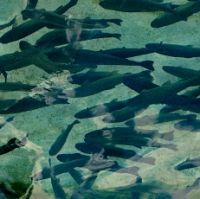

After two years in construction, the Colwick (Holme Sluices) fish pass on the River Trent is now complete and ready for fish to reach their spawning and feeding grounds.
The flagship project opens up the River Trent and its tributaries for migratory fish including salmon, trout and eels, making more habitat accessible for fish. It is part of the Environment Agency's work to improve fish passage across the country and provides a significant step in restoring the River Trent catchment to its former glory for salmon and other coarse and migratory fish.
Fish will now be able to navigate past the Environment Agency-owned Holme Sluices, a major flood risk management structure built in the 1950s which helps to protect Nottingham from flooding.
Simon Ward, Fisheries Technical Specialist at the Environment Agency, said: "We are excited to see the completion of the country’s largest fish pass after two years of construction, and many more years in the planning stages".
"The fish pass will open up the River Trent for all fish species and is the first scheme of the ambitious Trent Gateway Partnership which aims to remove all barriers to fish migration along the River Trent - the third longest river in the country".
"There are a number of barriers to fish migration within the River Trent catchment, including Holme Sluices, which is the largest barrier to the natural migration of fish in the Midlands. By installing fish passage, it will become easier for salmon and other fish to reach their spawning and feeding grounds".
"We are working with partners to improve the situation and hope that the Colwick fish pass will serve as a catalyst for other Trent Gateway projects, which will in turn enhance the river and boost the local economy".
The fish pass includes a two-metre-high fully automated radial gate which constantly monitors the water levels and flow rates in the River Trent. The pass will then open and close based on the differing water levels throughout the year.
The Colwick (Holme Sluices) fish pass is 200m long, 6m deep and 6.5m wide.
The pass is divided into 20 ascending chambers into which water flows through narrow slots. Fish of all species swimming upstream to lay their eggs in the gravel riverbeds of the Trent tributaries such as the River Dove and the River Derwent will be able to pass through these slots and rest in the chamber above before continuing to swim upstream.
The project also includes an eel pass to help support the critically endangered European eel, and a public viewing platform above the water, with highly visual interpretation boards to inform and advise visitors about the local wildlife in and around the river, including the fish that are expected to use the pass.
For more information on this subject, see: